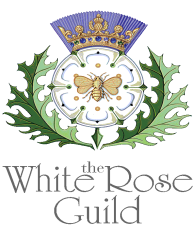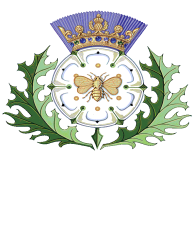Rob Beaton, Weaver
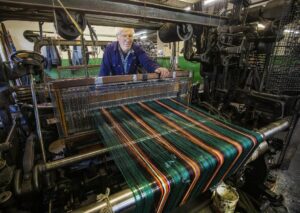 At the age of 14 Rob started working in the mills as an apprentice turner. Now aged 78 Rob continues to work hard designing and weaving tartan and tweed for Royals and celebrities alike.
At the age of 14 Rob started working in the mills as an apprentice turner. Now aged 78 Rob continues to work hard designing and weaving tartan and tweed for Royals and celebrities alike.
A master of all aspects of Mill work, Rob is now the longest working weaver in the Scotland.
Over the decades, Rob has worked at five mills in and around Galashiels and Selkirk and at one time he used to make a staggering 25 miles of fabric a week! His craftmanship has led to him weaving costumes for Mel Gibson’s ‘Braveheart’ and the Tweed for the ‘Doctor Who’ jacket, these are just a few of his many garments.
Using looms dating back to 1928 Scotland’s oldest weaver has told of his fears for the future of the industry, with no young people coming through to whom he can pass on his expertise it is feared this potentially a dying craft. The mechanisation has meant older looms like the ones he uses, some of which are nearly 100 years old, have fallen out of use and the knowledge about them has all but disappeared.
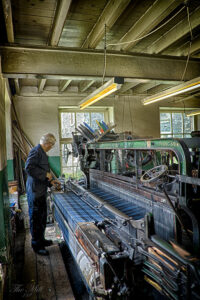 Though some tweed is produced in England, Ireland, and Germany, the majority still hails from Scotland. There are two main types: the colourful, tightly woven Harris Tweed of the Outer Hebrides and the more earthy-hued fabrics of the Scottish Borderlands and Highlands.
Though some tweed is produced in England, Ireland, and Germany, the majority still hails from Scotland. There are two main types: the colourful, tightly woven Harris Tweed of the Outer Hebrides and the more earthy-hued fabrics of the Scottish Borderlands and Highlands.
Tweed is a subtly patterned fabric made from dyed, spun, and woven wool from hardy local sheep. It’s been created in Scotland since the early 18th century, coming from outsized looms that spit out yardage from yarns originally dyed with the native lichen and wildflowers.
Tweed got its name by accident in 1826 in Hawick, when a merchant’s label on a shipment of wool tweel (the Scottish term for twill) bound for a London milliner was misread and confused with the moniker of the nearby River Tweed. Soon after, boosted by fresh techniques that made dyes brighter, and new train routes between Scotland and London, Hawick and nearby Galashiels became textile boomtowns with more than 20 mills producing tweeds.
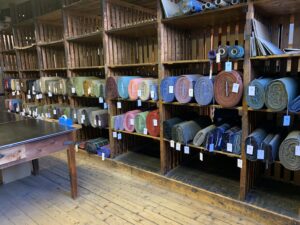 No one town or mill owns the history of tweed. Woollen fabrics have been part of daily life in Scotland for centuries, worn by farmers, game wardens, and athletes. Like the country’s other enduring Celtic textile traditions—clan tartans and fuzzy, zigzag pattern Fair Isle sweaters—tweed ties into geography, national pride, and the need to bundle up in the often-chilly weather.
No one town or mill owns the history of tweed. Woollen fabrics have been part of daily life in Scotland for centuries, worn by farmers, game wardens, and athletes. Like the country’s other enduring Celtic textile traditions—clan tartans and fuzzy, zigzag pattern Fair Isle sweaters—tweed ties into geography, national pride, and the need to bundle up in the often-chilly weather.
As of 2020, there are 191 double width Harris Tweed weavers and 39 single width Harris Tweed weavers.
With no plans to retire, Rob is still as enthusiastic as ever, working 5 days a week albeit part-time in the Scottish border town of Selkirk at Andrew Elliot Ltd where he is the sole weaver in the mill.
Although passionate about weaving, Rob is also a lifelong radio control plane enthusiast and goes out most Saturdays to fly is planes and he also has a background in Dirt Bike trials events in the UK and has designed many a course for these events.
With such a fascinating life it’s no surprise Rob has, more than a few stories to share and some would say his life story would make a very interesting read. Many years ago he met the band members of The Rolling Stones in the borders countryside, after chatting to the band, Mick Jagger asked him where they could find a hotel for a meal, Rob directed them to a hotel in Selkirk, Mick and the guys were in Robs words ‘immaculately dressed but all with long hair’, they went to the hotel and sat drinking in the bar when the owner walked in, an old military man who looked at them in the bar and not knowing who there were shouted “get out of my hotel you long haired yobs”
If you’re fortunate to meet Rob he’s got a few more stories to share, just ask him to tell you about how he came to rip up a leather jacket belonging to the Dam Busters Squad which he used as a chamois to clean his bikes!
